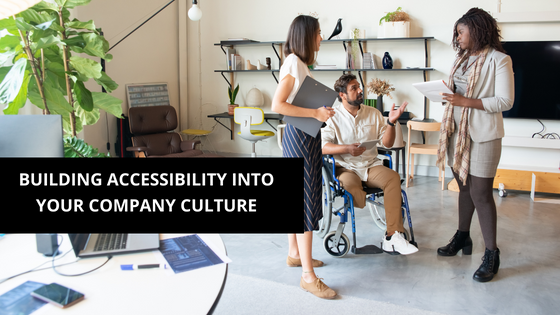When we think of accessibility, we usually think of wheelchair ramps and elevators. But there is so much more that can be done to make a company accessible. An accessible work culture encompasses the attitudes and beliefs of the organization and its employees. It results in effective communication, accessible work stations, and accessible programs and services.
The culture of an organization can make a huge difference in the work experience of employees. The culture is not just about the people in the organization, but also includes how they interact with each other and their environment. A company that has a culture that is inclusive, open, and supportive will have a much more positive work environment than one where employees feel they are not welcome or do not have the support they need to be successful.
Companies that want to build an inclusive and accessible culture in their workplace should focus on the following 5 things:
1. Incorporating Universal Design
Universal design is the design of products, environments and services that are usable by the widest possible group of people. The seven main principles of universal design are:
- Equitable use
- Flexibility in use
- Low physical effort
- Simple and intuitive use
- Perceptible information
- Tolerance for error
- Low visual clutter
The goal of universal design is to make sure that these people can use the same item or service without any modifications. A good example of this is a coffee machine which has a large button with Braille on it. Universal design should be applied to workplace environments so that all employees can work in a comfortable environment where they feel supported and respected.
2. Accessible Website and Job Portal
The number of job seekers who are applying for jobs online is increasing every year. Applicant accessibility is a key factor in hiring decisions, and companies are trying to make it easier for job seekers to apply for positions by making the application process simpler and more user-friendly.
If your online job application portal is not accessible, you are eliminating a potential applicant from the very beginning. An accessible job portal or company website sends a clear message that as an organization you value diversity and are actively working towards including employees with disabilities. Also, ensuring HR Onboarding documents are accessible is the perfect place to start as your organization continues to create an inclusive culture.
3. Providing Assistive Technology
The company should ensure that it provides accessibility tools or assistive technology for employees with disabilities. For example, the company could offer a screen reader for those who are blind or have low vision. They could also provide a speech recognition software that would allow people with mobility impairments to use their computer without the need of a mouse.
4. Flexible Work Policy
In the past, companies have been reluctant to hire disabled workers because they were not sure how to make accommodations for them. But now that the world has become more inclusive and understanding, more companies are hiring people with disabilities. Employer should consider implementing a hybrid or remote work policy. This would allow disabled employees to work from home when needed.
Check out this blog on Accessible Digital Ready Technology — Future of Work
5. Accessible Trainings & Meetings
Employees with disabilities should be afforded the same opportunities as everyone else to receive workplace training or be a part of company meetings. In order for every employee to be able to learn new skills, it is important that they feel comfortable in their learning environment. Training can take many forms, but all of it must be designed so that employees with disabilities can participate fully and effectively. All training materials and instructions needs to be made available in a format that is accessible so that everyone can take the benefit of them. Employers should establish policies and procedures for the management and distribution of training and other resources. These policies should be reviewed and updated as necessary to reflect changes in the workplace and the needs of employees with disabilities.
A culture of accessibility is key to the success of any company, and it is something that we should all be striving for. Inclusive workplaces are more successful, with higher productivity and better employee engagement. One of the most important factors in this is making sure that employees with disabilities are not left out. This means providing them with an inclusive environment to do their job. It may seem overwhelming, but it can go a long way towards making sure that all employees feel welcome and included in the workplace.
No matter what the level of your accessibility commitment as an organization is, choosing the right digital accessibility vendor is of utmost importance. Get in touch with our team today at info@barrierbreak.com to plan your accessibility roadmap.
